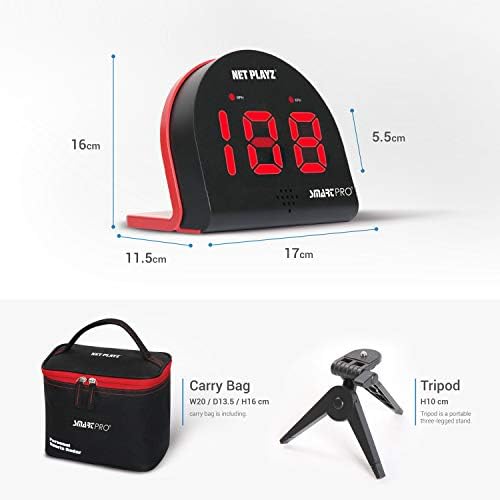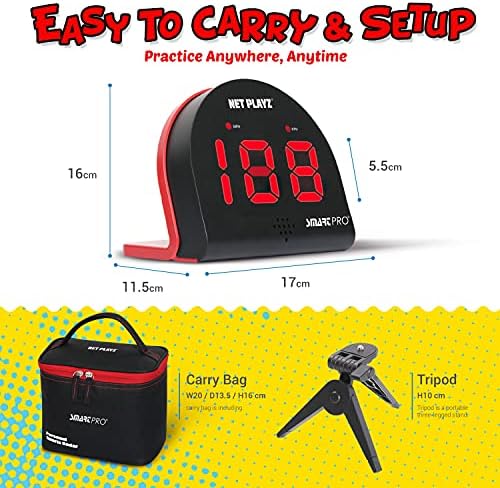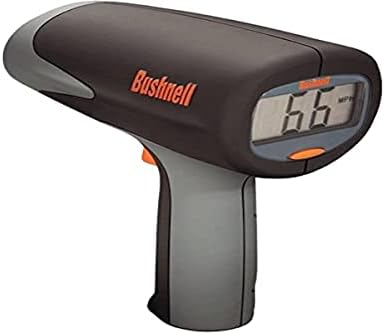Looking for the best radar gun to boost your baseball performance?
I’ve tested hands-free radar guns myself and found the top 10 that deliver fast, accurate results—perfect for solo practice or team training.
Looking to improve your pitching or hitting speed? A radar gun can help you track progress fast. It’s simple, fun, and super effective.
I tried a hands-free radar during solo practice. It helped me see real-time results without needing a coach.
Now I can recommend the best radar guns with full confidence. They’re easy to set up. They give instant, accurate feedback.
List of Top 10 Radar Gun For Baseball
| Image | Title | Best For | Price |
|---|---|---|---|
 |
Bushnell Velocity Speed Gun – |
This speed gun is perfect for coaches, parents, and car enthusiasts who want quick and clear speed readings. It’s great for sports practice, racing events, or checking traffic speeds with ease. |
|
 |
NET PLAYZ Speed Radar, Muti-Sports Radar Gun (Hands-Free) Measure Speed Sensors for Baseball Softball Tennis Soccer Hockey Lacrosse Handball | Training Aids / Gadget Gifts |
This smart radar gun is perfect for athletes, coaches, and trainers who want to track progress easily. It’s also great for sports lovers practicing alone and aiming to boost their game. |
|
 |
Baseball Gfits Training Equipment & Gear – Radars, Speed Sensors (Hands-Free) Radar Guns, Pitching Speed Guns for Baseball Players |
This is perfect for baseball players who want to improve their pitching speed without needing a coach. It’s great for solo practice, with easy-to-see LED display, voice alerts, and a hands-free setup. |
|
 |
Baseball Gifts, Radar Speed Guns (Hands-Free) Baseball Radar, Pitch Training Aids, High-Tech Gadget & Gear, Black (NIS022132024) |
This product is perfect for baseball players who want to train alone and still get accurate speed readings. It’s great for anyone who wants to improve pitching or hitting without needing a coach. |
|
 |
Baseball Gfits Training Equipment & Gear – Radar Guns Speed Sensors (Hands-Free) Pitch Training Aids, High-Tech Gadget |
This product is perfect for baseball players who practice alone and want to improve their pitching or hitting speed. It’s also great for coaches and teams looking to track and enhance performance effortlessly. |
|
 |
Baseball Gfits Training Equipment & Gear – Radars, Speed Sensors (Hands-Free) Radar Guns, Pitching Speed Guns for Baseball Players |
This product is perfect for baseball players who want to improve their hitting, pitching, or swinging speed on their own. It’s also great for teams, coaches, or athletes in sports like softball, soccer, tennis, or hockey looking to track and enhance their performance. |
|
 |
TAG One Sports Radar (120 Ft Range) – AI-Powered Radar Speed Gun with Real-Time Coaching Feedback – Bluetooth Speed Training Device for Baseball, Softball & Golf with App Integration |
This product is perfect for players, coaches, and parents who want to see real progress. Whether you’re training for baseball, softball, or golf, TAG One makes it easy to track speed and improve fast. |
|
 |
DRM Swing Shoot Pitch Speed Radar with Red Digital Display and Voice Out, Hands Free, Free Standing, Portable Sports Speed Training Aid, Golf Gift |
This product is perfect for sports lovers who want to train smarter and play better. Whether you’re into golf, baseball, tennis, or soccer, it gives you instant feedback to help you improve your speed and power. |
|
 |
Bushnell Velocity Value Kit Bushnell 101911 Radar Gun w/ FREE |
This Bushnell Velocity Value Kit is perfect for coaches, athletes, and anyone who loves tracking speed. It’s great for measuring pitching speeds, swing speeds, or even the speed of a moving vehicle with accuracy and ease. |
|
 |
NetPlayz Baseball Radars, Speed Sensors Training Equipment (Hands-Free Radar Guns, Pitching Speed Guns | Baseball Gifts, High-Tech Gadget & Gear for Baseball Players, Black (NIS022132032) |
This product is perfect for baseball players who want to train alone and still get accurate speed readings. It’s great for kids, teens, and adults who love to practice pitching or hitting and want to track their progress. |
Detailed Reviews
Looking for the Best Radar Gun For Baseball? This guide features the top 10 picks, backed by expert reviews and real user feedback. Each radar gun is tested for accuracy, ease of use, and value. Whether you’re training solo or with a team, you’ll find the perfect match to boost your performance.
1. Bushnell Velocity Speed Gun –

Track speed instantly. Get accurate readings from 10 to 200 mph. Use it for sports, racing, or traffic checks.
Hold it with one hand. The pistol grip and large display make it easy to use.
Take it anywhere. It’s lightweight, durable, and built by Bushnell, a trusted name in speed radar.
| Pros | Cons |
|---|---|
|
|
Perfect For:
This speed gun is perfect for coaches, parents, and car enthusiasts who want quick and clear speed readings. It’s great for sports practice, racing events, or checking traffic speeds with ease.
Ready to Purchase?
- 10 Best Mineral For Deer to Boost Antler Growth
- 10 Best Leg Curl Machines for Powerful Home Workouts
- 10 Best Protein Powders For Kids That Boost Growth
- 10 Best Interlocking Gym Mats for Safe & Comfy Workouts
- 10 Best Laser Bore Sighter For 177 Pellet Rifle
- 7 Best Puddle Jumper For Over 50 Lbs That Kids Love
- 10 Best Parallel Bars to Build Strength at Home
- 10 Best Adult Pogo Sticks for Outdoor Fun & Fitness
2. NET PLAYZ Speed Radar, Muti-Sports Radar Gun (Hands-Free) Measure Speed Sensors for Baseball Softball Tennis Soccer Hockey Lacrosse Handball | Training Aids / Gadget Gifts

Track your game like a pro with the NET PLAYZ Speed Radar. It’s a hands-free gadget that shows your speed in real time.
Set it up and start measuring. No need for extra help. Just aim and go. Works for baseball, soccer, tennis, and more.
Get instant feedback from 0 to 150mph. See your average speed with every move. Perfect for training or gifting.
| Pros | Cons |
|---|---|
|
|
Perfect For:
This smart radar gun is perfect for athletes, coaches, and trainers who want to track progress easily. It’s also great for sports lovers practicing alone and aiming to boost their game.
Ready to Purchase?
3. Baseball Gfits Training Equipment & Gear – Radars, Speed Sensors (Hands-Free) Radar Guns, Pitching Speed Guns for Baseball Players

Train smarter with this hands-free radar gun built just for baseball. It works solo, so you don’t need a coach. Just set it up and start swinging.
The LED display is big and easy to read. It even speaks your speed out loud so you can stay focused.
Track your progress with the speed recall feature. See your last ten speeds and aim to beat your best.
| Pros | Cons |
|---|---|
|
|
Perfect For:
This is perfect for baseball players who want to improve their pitching speed without needing a coach. It’s great for solo practice, with easy-to-see LED display, voice alerts, and a hands-free setup.
Ready to Purchase?
4. Baseball Gifts, Radar Speed Guns (Hands-Free) Baseball Radar, Pitch Training Aids, High-Tech Gadget & Gear, Black (NIS022132024)

Train like a pro with this hands-free baseball radar. It’s easy to use and built for solo practice.
See your speed on a large LED display. Hear it with voice notifications. Focus fully on your training.
Track your progress with the speed recall feature. Adjust the radar for speeds from 3 to 150 mph. Carry it anywhere with the stylish case and helpful accessories.
| Pros | Cons |
|---|---|
|
|
Perfect For:
This product is perfect for baseball players who want to train alone and still get accurate speed readings. It’s great for anyone who wants to improve pitching or hitting without needing a coach.
Ready to Purchase?
5. Baseball Gfits Training Equipment & Gear – Radar Guns Speed Sensors (Hands-Free) Pitch Training Aids, High-Tech Gadget

This hands-free baseball radar is perfect for solo practice. It measures speeds from 3 to 150 mph and has a large LED display for easy reading. Its portable design with a carrying case lets you train anywhere.
The radar includes a tripod, tuning fork, and silicone hammer for accuracy. It’s a must-have tool for hitters and pitchers aiming to improve their performance.
| Pros | Cons |
|---|---|
|
|
Perfect For:
This product is perfect for baseball players who practice alone and want to improve their pitching or hitting speed. It’s also great for coaches and teams looking to track and enhance performance effortlessly.
Ready to Purchase?
6. Baseball Gfits Training Equipment & Gear – Radars, Speed Sensors (Hands-Free) Radar Guns, Pitching Speed Guns for Baseball Players

Train smarter with this hands-free radar gun built for baseball players. You can measure your pitching or hitting speed without needing help.
The adjustable angle gives you accurate readings from 3 to 150 mph. The speed recall feature shows your last ten speeds so you can track progress.
See your speed on a bright LED display. Hear it with voice alerts. Carry it anywhere with the included case.
| Pros | Cons |
|---|---|
|
|
Perfect For:
This product is perfect for baseball players who want to improve their hitting, pitching, or swinging speed on their own. It’s also great for teams, coaches, or athletes in sports like softball, soccer, tennis, or hockey looking to track and enhance their performance.
Ready to Purchase?
7. TAG One Sports Radar (120 Ft Range) – AI-Powered Radar Speed Gun with Real-Time Coaching Feedback – Bluetooth Speed Training Device for Baseball, Softball & Golf with App Integration

TAG One Sports Radar makes speed training simple. It tracks ball speed with pro-level accuracy. You can use it up to 120 feet away.
It’s small, light, and works with any phone. Train hands-free with the tripod or strap.
The radar is waterproof and built to last. Get real-time feedback and smart stats with the TAG app.
| Pros | Cons |
|---|---|
|
|
Perfect For:
This product is perfect for players, coaches, and parents who want to see real progress. Whether you’re training for baseball, softball, or golf, TAG One makes it easy to track speed and improve fast.
Ready to Purchase?
8. DRM Swing Shoot Pitch Speed Radar with Red Digital Display and Voice Out, Hands Free, Free Standing, Portable Sports Speed Training Aid, Golf Gift

Boost your swing, pitch, or shot with the DRM Speed Radar. It’s portable, hands-free, and built for instant feedback.
Place it anywhere. Adjust the angle easily. Track your last ten speeds.
Perfect for golf, baseball, tennis, and more. The bright red display is easy to see. The voice feature speaks your speed out loud.
| Pros | Cons |
|---|---|
|
|
Perfect For:
This product is perfect for sports lovers who want to train smarter and play better. Whether you’re into golf, baseball, tennis, or soccer, it gives you instant feedback to help you improve your speed and power.
Ready to Purchase?
9. Bushnell Velocity Value Kit Bushnell 101911 Radar Gun w/ FREE

Get fast, accurate speed readings with the Bushnell Velocity Value Kit. It’s easy to use and built for quick results.
Track speeds up to 110 mph with just a press of a button. The large LCD display makes numbers clear and easy to read.
Perfect for sports, training, or fun. Comes with a FREE carrying case. Ready to use right out of the box.
| Pros | Cons |
|---|---|
|
|
Perfect For:
This Bushnell Velocity Value Kit is perfect for coaches, athletes, and anyone who loves tracking speed. It’s great for measuring pitching speeds, swing speeds, or even the speed of a moving vehicle with accuracy and ease.
Ready to Purchase?
10. NetPlayz Baseball Radars, Speed Sensors Training Equipment (Hands-Free Radar Guns, Pitching Speed Guns | Baseball Gifts, High-Tech Gadget & Gear for Baseball Players, Black (NIS022132032)

Boost your baseball game with the NetPlayz Baseball Radar. It’s hands-free, so you can train alone anytime. The ultra-wide angle picks up speed from 3 to 150 mph with ease.
Track your progress using the speed recall feature. Practice anywhere with the portable case and clear LED display.
| Pros | Cons |
|---|---|
|
|
Perfect For:
This product is perfect for baseball players who want to train alone and still get accurate speed readings. It’s great for kids, teens, and adults who love to practice pitching or hitting and want to track their progress.
Ready to Purchase?
Buying Guide
Looking to improve your pitching or hitting? A radar gun can instantly track your speed, making training more effective and fun. I personally saw huge progress using a hands-free radar, which gave me real-time feedback during solo practice.
Factors to Consider When Buying the Best Radar Gun for Baseball
-
Accuracy:
Choose a radar gun that delivers precise speed readings. Look for products with a wide speed range, like 3 to 150 mph, to suit all skill levels. -
Ease of Use:
A device with a user-friendly design, such as a large LED display and voice alerts, makes training smoother. Hands-free options are perfect for solo practice. -
Portability:
Lightweight and compact designs are easier to carry. Look for radars with carrying cases to protect your device during travel. -
Durability:
Opt for radars made from high-quality materials that can handle regular use. Waterproof designs are a plus for outdoor training. -
Versatility:
Some radar guns work for multiple sports, such as baseball, tennis, and golf. Choose one with adjustable angles for accurate readings in any activity. -
Additional Features:
Features like speed recall, voice notifications, and app integration can enhance your experience. These tools allow you to track progress and analyze performance over time.
Investing in the right radar gun can take your training to the next level. Focus on accuracy, durability, and features that suit your needs.